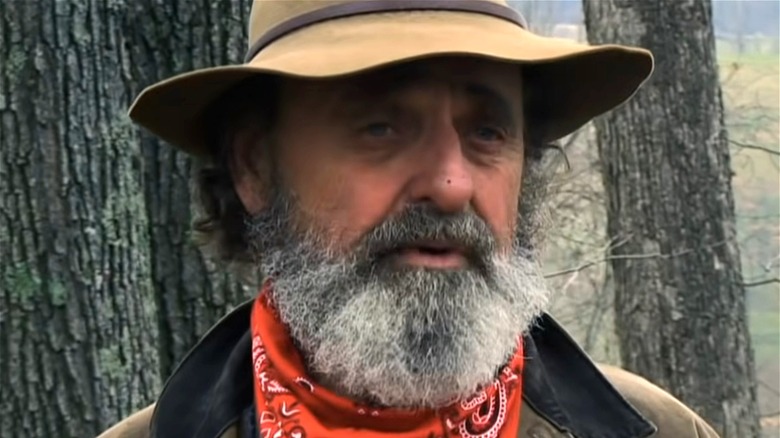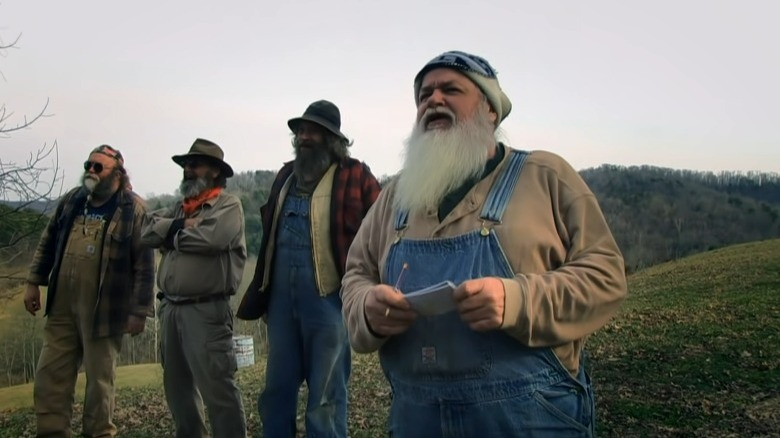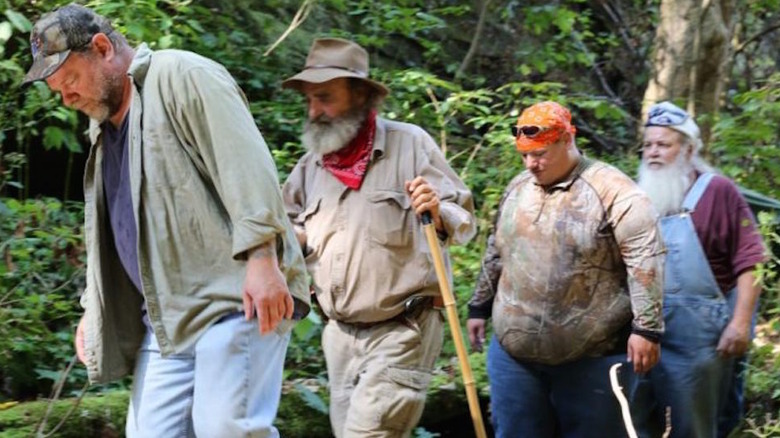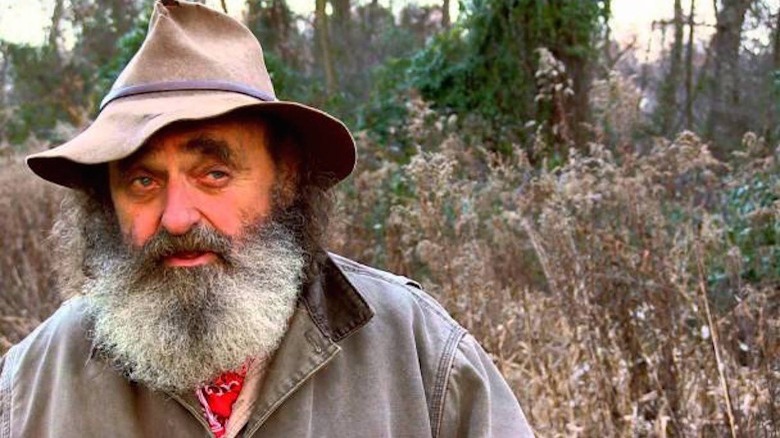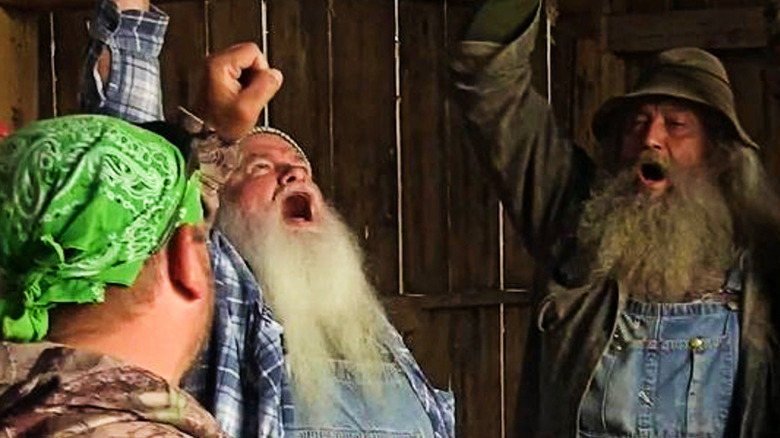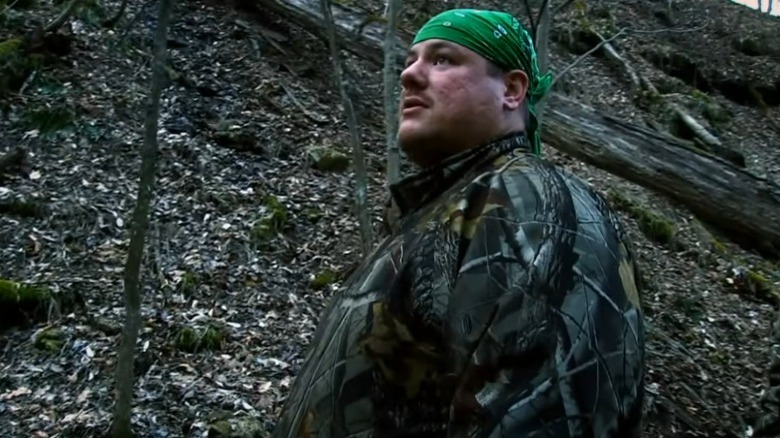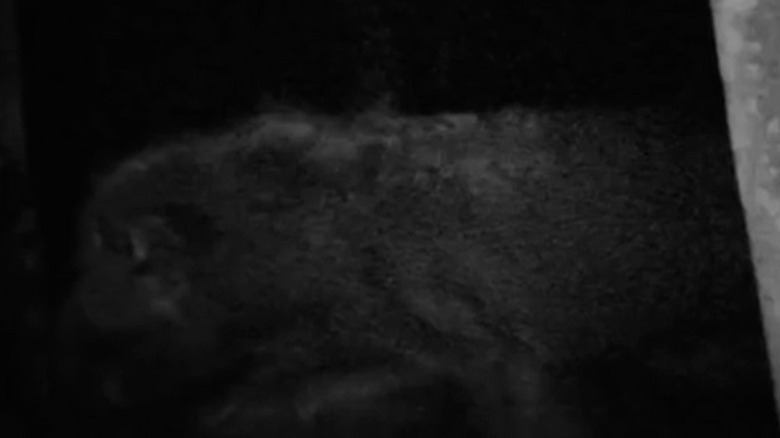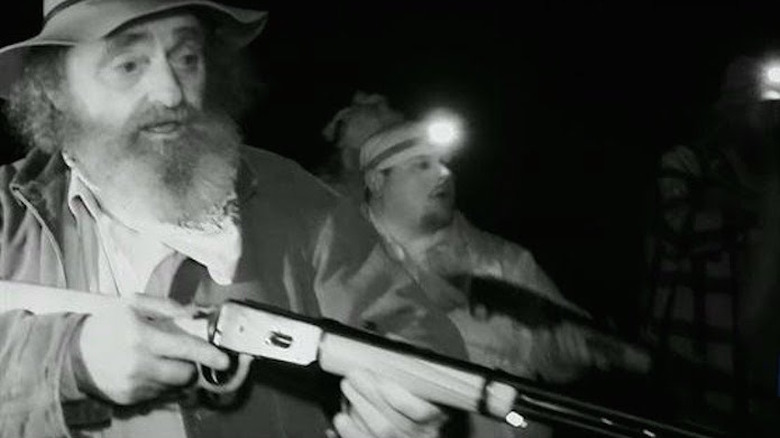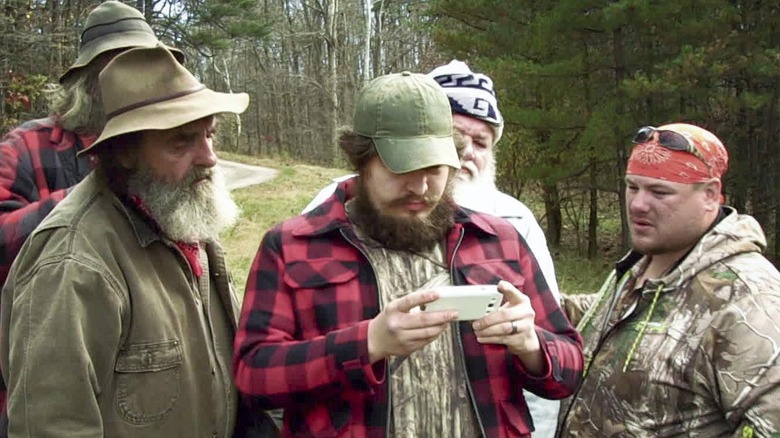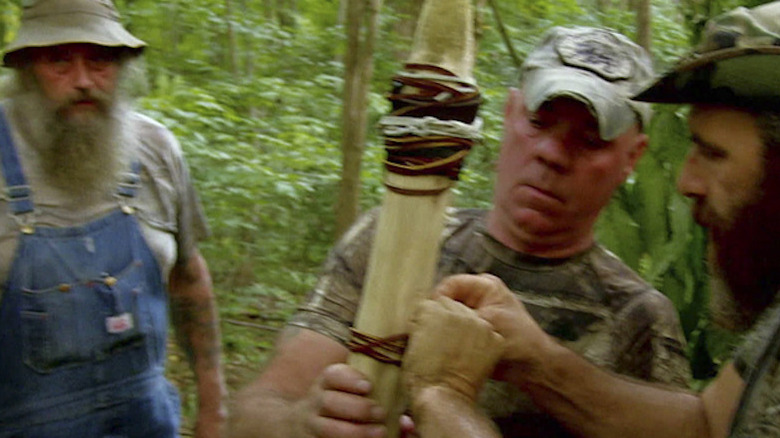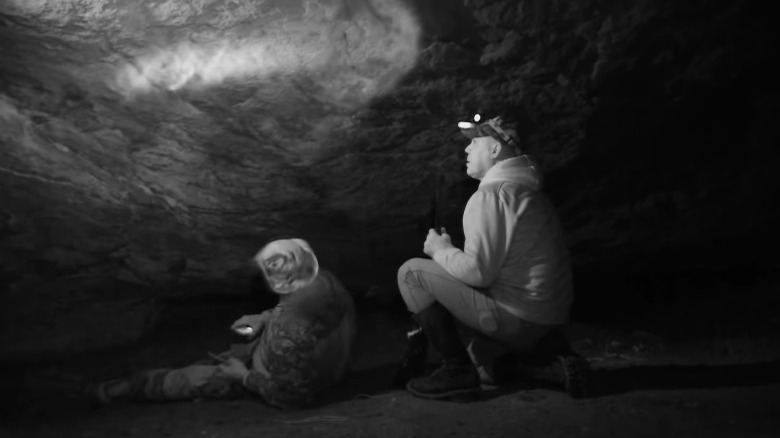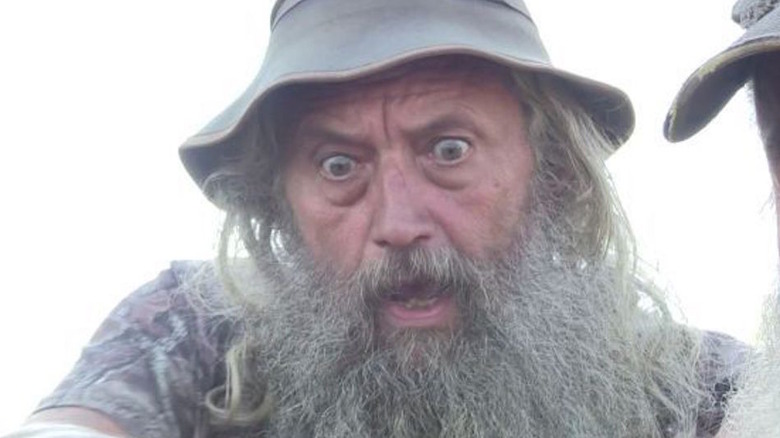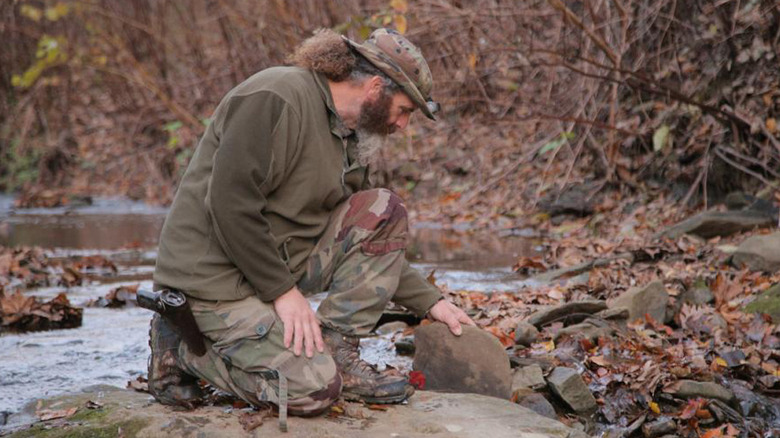What You Probably Never Knew About Mountain Monsters
For eight seasons, the paranormal reality series "Mountain Monsters" invited viewers to join a crew of hearty investigators as they trekked through the woods of Midwest and Southeast America in search of what could only be described as legends come to life. The series, which initially aired on the Destination America network before moving to the Travel Channel and then Discovery +, followed the Appalachian Investigators of Mysterious Sightings (AIMS).
These West Virginia trappers and hunters delve into reports of legends of cryptozoology such as Bigfoot and Mothman and even claim to have crossed paths with the monsters. The show's mix of procedural investigation, creature feature tropes, and homespun humor proved popular with viewers, who followed the series as it took unusual format turns. These unusual turns included a dive into seemingly scripted fantasy-folk horror in Season 5 (subtitled "Secrets of the Dark Forest") — and the loss of the team's anchor, "Trapper" John Tice.
That curious combination of elements helped "Mountain Monsters" retain a faithful following for nearly a decade since its launch in 2013. Whether you're a veteran "Mountain Monsters" fan or preparing for your first excursion with the AIMS team, there's a wealth of information to absorb about the show's participants, production history, and even the folklore behind the team's monstrous targets. Following is a list of what you probably never knew about "Mountain Monsters."
Be warned, however — spoilers lie ahead!
Mountain Monsters and the real-or-not debate
One of the most consistent questions asked about "Mountain Monsters" is the authenticity of the team's investigations. In each episode, Trapper and his cohorts seek out a cryptid rumored to lurk in the rural Southeast or Midwest. As with other monster-hunting reality programs, the team comes within tantalizing reach of locating or capturing the beast of the week — only to see it slip from their grasp at the last minute. So are they really hunting monsters, or is the action all scripted material?
Trapper dismissed such suggestions in a 2014 interview with the Ohio's Country Journal. "We have no scripted lines," he asserted. However, it's not the banter between team members that generate skeptical reactions. The fact that the team has yet to find a single piece of compelling evidence for the existence of any creature over the course of eight seasons is perhaps a stronger reason for doubting the veracity of the series. Of course, as observed by Scientific American, the same can be said for virtually any cryptozoology expedition conducted over the past half-century or more.
The team has managed to capture a few images of their quarry, including glimpses of the Ohio Grassman and Cherokee Death Cat. However, all of the photos are too blurry to pass as actual evidence of these creatures' existence. In some cases, those photos are simply swapped out for computer-generated images. Then again, investigations far better equipped than the AIMS team also haven't produced any pictures that offer more conclusive evidence. The question of whether "Mountain Monsters" is real or not remains, like their quarry, wrapped in questions.
Finding Bigfoot had a big beef with Mountain Monsters
On "Mountain Monsters," the AIMS team had their hands full with the mysterious Rogue Team, which barged into their investigations in Seasons 4 and 5 before dispatching them on the hopelessly convoluted search for the Woman of the Woods. However, the team also had problems with another band of monster hunters when the cameras were turned off. In 2015, a feud between the "Mountain Monsters" crew and the team on Animal Planet's "Finding Bigfoot" erupted in a flurry of finger-pointing and naysaying on social media.
Matt Moneymaker, a member of the "Finding Bigfoot" team, fired the first salvo in April of that year when he claimed on his Twitter account that "'Mountain Monsters' is a scripted fictional show.'" Trapper John Tice soon fired back that "Finding Bigfoot" should be called "Losing Bigfoot." That burn set in motion a volley of criticisms between the two camps for the next two years, culminating in a tweet from the official "Finding Bigfoot" account that labeled "Mountain Monsters" a "hoax-fake show" — whatever that is. The two teams appear to have either settled their differences or simply lost interest in firing off insults, as no further exchanges have surfaced.
Tracking mountain monsters is hard work
There's no question that the search for mysterious creatures put the AIMS team through some tough terrain. Numerous episodes of "Mountain Monsters" showed Trapper and his partners navigating thickly wooded areas, traipsing through heavy brush or through soggy river beds, or biding their time in the dead of night for a glimpse at a cryptid. In a 2014 interview with the Ohio's Country Journal, Trapper confirmed that there was little Hollywood glamour involved in the production of "Mountain Monsters."
"For 43 minutes and 50 seconds of television, we film with three Emmy-award winning camera men for four or five days," he told the Ohio Country Journal. "Most of those days are 12-hour-plus days." Trapper also detailed their weekly shooting schedule, which encompassed four to five days of filming, a day of travel, and then another four-to-five-day shooting week. Most of their filming took place during the fall and winter months, which dropped to perilously low temperatures. "[In] January, when it was 12 below zero in Ohio, we were out there every day," Trapper said.
Trapper fell in love with monsters as a kid
How do you make a monster hunter? In the case of John Tice, aka Trapper, a childhood steeped in folk tales spurred an interest in mysterious places and creatures that carried through to adulthood. In an interview with the Ohio's Country Journal, Tice recalled the spooky stories of his younger days. "It all started back probably in the '40s and '50s sitting on front porches before television," he said. "Radio wasn't very good either so we listened to folklore tales. That was a big deal. It was ghost stories and stories of monsters. The kids were always threatened that some kind of monster was going to get them."
Tice continued to nurture his interest in strange local legends after time in the service and a career as a boilermaker. In the early 2000s, he collaborated with his son on research into legends about Ike's (or Ikie's) Tomb, a burial vault in West Virginia where the body of a boy could be allegedly visited by his parents. That information, published in the journal Goldenseal, led to more investigation and the eventual formation of the AIMS team.
Hogzilla was dead long before the AIMS team found it
In Season 2, the AIMS team lit out for Hocking Hills, Ohio to investigate rumors of a colossal swine terrorizing area farms since the 18th century. According to local legend, the beast, dubbed "Hogzilla," measured nine feet in length and weighed in at approximately 1,200 pounds. It also appeared to possess the ability to stand and walk on its hind legs due to some human-like extremities. Trapper and the team constructed a special steel trap that snared the monster pig in the episode's finale, providing a rare example of a Mountain Monster brought to heel by AIMS.
The capture of Hogzilla should have been reason to rejoice for both AIMS and fans, were it not for the fact that a creature known by that name was already located back in 2004. That Hogzilla was something of an internet celebrity when an image of its carcass dangling over a pit drew widespread media attention (via NBC). According to two individuals –- the person who shot the hog and the owner of the property on which it was killed -– the pig weighed more than 1,000 pounds and measured 12 feet from snout to tail.
Authorities doubted those measurements, given that hogs rarely grow in excess of seven feet in length. A team of National Geographic experts exhumed the hog's carcass and found it (via ESPN) to be just seven-and-a-half feet in length and weighed 800 pounds. While still a monster-sized hog, it was within recorded limits and possessed no human-like appendages.
The tragic death of Trapper
Though a guiding force for the AIMS team in the first three seasons of "Mountain Monsters," John Tice stepped away from active investigations in the first episode of Season 4, which concerned the Stonish Giant. His reduced presence on the series spurred rumors in 2016 that he had passed away during filming, which Discovery Communications attempted to quash in a statement (via Ohio's Country Journal). However, Trapper's reduced tenure with the series would only last a few more seasons. In 2019, his family revealed that the 72-year-old had passed away on December 16, 2019, after a brief illness.
The death of Trapper led many fans to believe that "Mountain Monsters" would also come to an end. However, the Travel Channel issued a statement in 2020 that confirmed the show's return for Season 7, which kicked off with a special tribute episode. Trapper remained a presence on the series through a journal he left for the team, which revealed a new set of adventures centered around the search for sinister creatures known as Smoke Wolves.
What exactly was the Fire Dragon
In Season 2, the AIMS team visited West Virginia's Pocahontas County to investigate rumors of an aquatic reptile that, according to eyewitness descriptions, resembled a dragon of folk and fairy tales. The Fire Dragon, which was described as being 10 to 12 feet in length, used the area's waterways -– Pocahontas County contains the headwaters or sources for no less than eight of the state's major rivers –- to travel and seek out food. As for the "fire" part of its name, the dragon was reportedly attracted to heat sources as a source of energy, and as the conclusion of the episode showed, drew upon a campfire to gain enough strength to bite a boat and escape the team's water trap.
"Fire Dragon of Pocahontas Country" is a fun bit of kaiju-style action and might be even more entertaining were there any folkloric basis for the creature. However, research into fire dragons -– or any dragons -– in West Virginia turns up no reference to any such creature, despite the team's claims that reports of the monster date back to the early 20th century. It's possible that the beast is a riff of sorts on several giant serpents in Native American folklore -– the mythology of the Seneca people includes Gaasyendietha, which not only spewed flame but also flew on a trail of fire –- but in terms of West Virginia tall tales, there's no apparent basis for the Fire Dragon.
The ferocious (and probably fictional) Cherokee Death Cat
Another Season 2 hunt puts the AIMS team on the trail of a colossal feline monster in North Carolina. There, the boys look into reports of a massive creature known as the Cherokee Death Cat. This legend supposedly had a taste for livestock and an alleged connection to a real-life tragedy –- specifically, the Trail of Tears, which was the forced displacement of thousands of Native Americans from their tribal lands by the U.S. government between 1830 and 1850. Reportedly, the cat made its first appearance during this event and brought death to anyone that encountered it. The AIMS team managed to escape with not only their lives after tracking the Cherokee Death Cat, but even generated a few blurry trail camera photos of what appeared to be a huge predatory cat.
However, as with the Fire Dragon, the Cherokee Death Cat appears to be the product of the series' producers more than any actual folk talent or local mythology. However, it's also based in part on fact, as cougars were prevalent in North Carolina in the 19th century but are today considered an extinct species in the area. However, sightings of large cats that resemble cougars are often cited in North Carolina and other coastal Southeastern states, but these creatures rarely exceed six feet in length and 200 pounds -– a housecat compared to the Death Cat, which reportedly weighed 500 pounds.
The Hellhound has a long and frightening history
Season 2 of "Mountain Monsters" kicked off with a visit to Pike County, Kentucky, where the team looked into sightings of a massive canine that terrorized local farmers. The team deduced that this was a hellhound, one of many supernatural dogs that can be found throughout history and folklore all over the world. The team set a trap for the monster in a nearby cornfield, but their plans fell apart when the creature itself reportedly appeared, knocking over Trapper and leaving chaos in its wake. Adding to the mystery were suggestions that the hellhound was working in concert with a Bigfoot to spread fear throughout Pike County.
Though a surprising number of cryptids on "Mountain Monsters" appear to be wholly fictitious, the hellhound and other mysterious dogs have been a fixture of folklore in Kentucky and other parts of the world for centuries. Stories about mythical creatures in the Appalachian region of the U.S. date back to the Depression era and continue to this day in other parts of the country. However, the team's allegations of a team-up between the Hellhound and Bigfoot appear to be pure invention, with no apparent previous collaborations noted in folklore or sightings.
The Shadow Creature might be many different monsters
The Shadow Creature of Braxton County, which the AIMS team pursues in Season 2, is a mysterious entity — even for a show about mystery monsters. Described as a 7-foot tall humanoid with an outer layer that resembled an exoskeleton, the Shadow Creature also displayed extraordinary strength that allowed it to leap great distances and a taste for deer. It also appeared to be clever enough to escape being snared by the team's trap and even made off with the bait.
The graphic image of the Shadow Creature shown in the episode represents a sort of reptilian monster, which suggests that it might be similar to such urban legends as the Lizard Man of Scape Ore Swamp or Loveland Frogman, while its jumping ability brings to mind Kentucky's Demon Leaper, though that monstrosity was said to resemble a bat or monkey. The monster's name also brings to mind the Shadow People, which have been linked to sleep paralysis, though it appears to be more substantial than those entities, which are closer to spirits than corporeal figures.
If there's any real-world correlation to the Shadow Creature, it might be the Flatwoods Monster, an alleged extraterrestrial with glowing eyes and a metallic costume that terrorized a group of children and adults in a small town in Braxton County in 1952. A dash of that creature, a hint of other humanoids, and maybe even a pinch of the Predator –- that might be the origin story of the Shadow Creature.
This Bigfoot family might be bogus
The noisy Sasquatch siblings known as Lightning Man and the Thunder Brothers warranted two episodes of Season 4, and for good reason — according to "Mountain Monsters" lore, there were enough of them to almost fill out a regulation baseball team. The Lightning and Thunder posse gained its unique, pro-wrestling-style moniker from their penchant for making booming noises by hurling rocks against trees, which made them more of a nuisance than an actual threat. Despite this, the team pulled out the stops to assemble a mythical axe that kept the creatures at bay.
As with many of the creatures featured on "Mountain Monsters," Lightning Man and the Thunder Brothers appear to be a fabrication of the show's producers. That said, there are a handful of Native American legends that involve entities associated with thunder and lightning. The Ioway people describe four tiny beings, two of which are named Lightning-man and Thunder-man, while the Passamaquoddy and other Northeastern tribes told stories about the Seven Thunders, who were winged storm spirits with long hair.
However, none of these figures fit the bill for Native American interpretations of Bigfoot, so the connection between the show's version and actual folklore remains unclear.
The witches that inspired the Woman of the Woods
The Woman of the Woods is part of the overarching storyline that drives Season 5 of "Mountain Monsters," which involves the search for the Woman of the Woods, a mythical figure located in an area purportedly in Lee County, West Virginia called the Dark Forest. The AIMS team, which is broken into different factions for the majority of the season, encounters a host of other creatures in the area, including a monster wolf and a mysterious little girl before Buck appears to come face to face with the terrifying Woman of the Woods in the finale.
The exact mythology behind the series' depiction of the Woman of the Woods is unclear. She appears to be informed by forest-dwelling witches and supernatural figures from Native American folklore like Dzunukwa, a forest-dwelling giant with an appetite for children in the Kwakiutl people of the Pacific Northwest, as well as stories of spectral women like La Llorona or various White Ladies -– ghosts of women who haunt parks and cemeteries throughout the United States and across the world. Given the stick figures and other ominous symbols seen throughout the season, the Woman of the Woods may also be the series' riff on "The Blair Witch Project."
Spearfinger might be the scariest Mountain Monster
Having tussled with the Woman of the Woods in Season 5, the "Mountain Monsters" team moves on to another frightful folklore female in Season 6. Spearfinger, a monstrous figure from Cherokee legend is the team's ultimate quarry, as determined by the mysterious figures in the Rogue Team. However, to locate her the team also has to locate several other monsters, including a huge hominid, the Silver Giant, as well as the monster canine the Coyote King and even an old foe, the Cherokee Death Cat. Once this Labors of Hercules-style list is completed, the team faces off against Spearfinger, who seems to be one of their most dangerous challenges to date.
Spearfinger is a legitimate figure from Cherokee mythology and also one of its most nightmarish. A shapeshifter with a taste for human livers, and especially those of Cherokee children, Spearfinger haunted the mountains between the eastern border of Tennessee and the western region of North Carolina. Though her footfall sounded like thunder and her face was streaked with blood, Spearfinger was able to infiltrate Cherokee villages due to her shapeshifting abilities. After assuming the form of a trusted figure like a village elder or grandparent, she lulled children to sleep and then plucked out their livers with a long, sharp finger that resembled a knife or spear.
Though legend suggests that a council of Cherokee finally defeated the monster, any self-respecting folklore fan knows that the best villains always find a way to come back.
Grafton Monster: headless horror or hoax
The AIMS team makes another "real-life" monster their quarry in Episode 2 of Season 2. The Grafton Monster, a burly biped that has been part of the Mountain State's folklore since the early 1960s, is depicted in the episode as a voracious carnivore with a particular appetite for cows and deer. After reviewing eyewitness testimony (and a particularly shoddy-looking video purporting to show the creature), the AIMS team again sets a trap in hopes of capturing the beast. However, once again, a monster proves too clever for their scheme, leaving behind an untouched snare and an awful lot of blood from various animals.
The "Mountain Monsters" version of the Grafton Monster has a superficial resemblance to a description (via West Virginia Explorer) given by reporter Robert Cockrell, who saw the creature lumbering along a road near the Tygart Valley River in 1964. Cockrell noted that the monster was approximately nine feet tall with a muscular body covered in white fur. That's roughly what appears in the video and the CG mockup of the creature seen by the team, albeit with one major exception: it has a prominent, ape-like head. Cockrell's report noted that the creature appeared as if its head was either slung low on its neck or had no head at all, which provided the residents of West Virginia with its enduring nickname: the Headless Horror.
